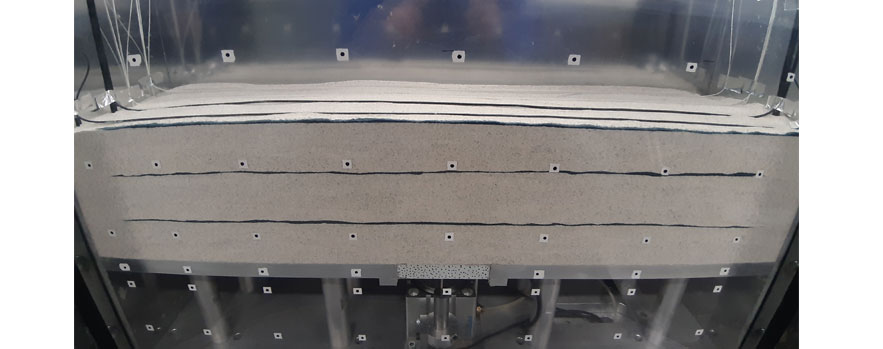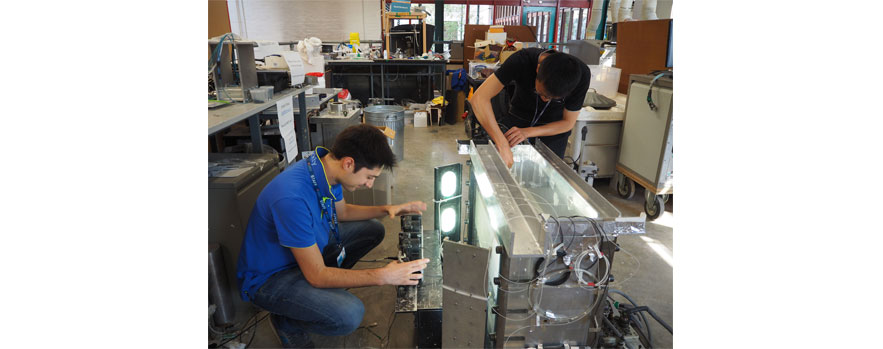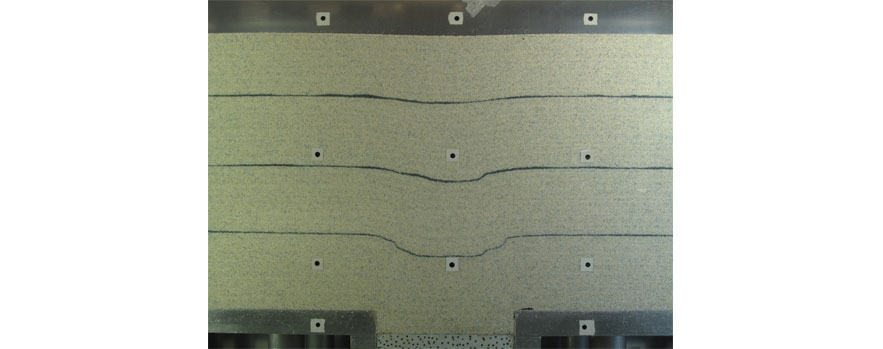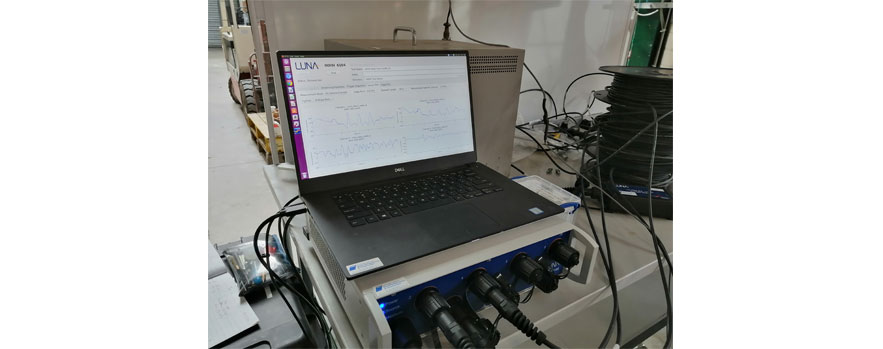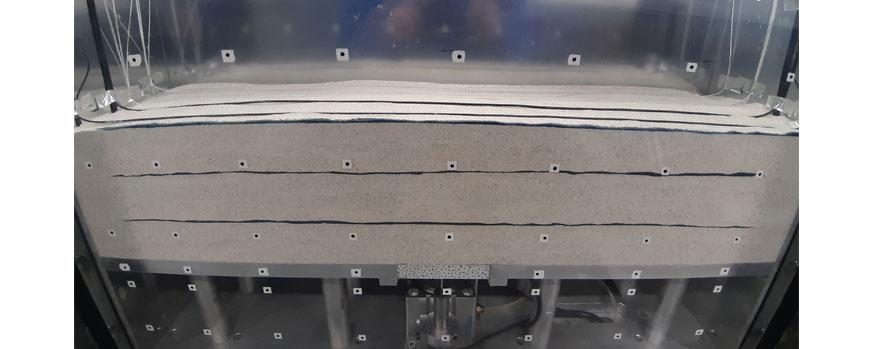
The occurrence of sinkholes during construction can have devastating consequences. The development of an early warning system to predict early formation of sinkholes before they caused property damage or even loss of life would be of huge benefit to the infrastructure and construction industry. “We know the areas they are likely to occur but sinkhole events are impossible to predict because there are so many different processes that can cause them,” said Dr Helen Reeves, British Geological Survey.
Our objective is to prove the feasibility of using a fibre optic sensing system to detect zones of subsidence in the soil that could potentially damage infrastructure and cause loss of lives. Our team is making promising progress towards identifying a signal signature that could help locate and mitigate this type of natural disaster.
Dr Christelle Abadie, Lecturer in Civil Engineering, University of Cambridge
Conditions for sinkhole formation
Sinkholes can best be described as a depression or hole in the ground caused by the collapse of the surface layer into a subterranean void. These can be caused by different events including the collapse of underground mine workings or the dissolution of salt deposits or soluble rocks including limestone, chalk, gypsum and dolomite, all of which are widespread across the UK.
Sinkhole formation can be triggered by changes in drainage conditions, for example natural flooding or leaking or burst water pipes, which accelerate the formation of the underground voids until the surface can no longer support itself and it collapses.
Changes in land use, such as construction and development, can place additional loading above an existing void and result in the collapse of otherwise stable ground. The most dangerous types of sinkholes are those that form without any apparent warning causing catastrophic damage to infrastructure and potential loss of life.
Sinkholes and construction
Often in the development of transportation networks, for example road and railways, the infrastructure is required to cross geotechnically challenging areas such as karstic environments or undermined areas. It is not always technically feasible or economically viable for these problematic void-forming areas to be avoided. A timely example includes the current development of the HS2 network where the presence of deep salt karst and shallow mining along part of the route has been identified as technically challenging for its design and construction. In such cases as these, it would be advantageous to the infrastructure owner to have detailed monitoring of ground conditions to provide an early warning of sinkhole development by identifying the accumulation of settlements at either the surface or within the supporting ground layers. This would allow early intervention such as filling the growing void or closing off the sinkhole risk area prior to collapse.
Despite an increased interest in this phenomenon, there is no robust method yet available capable of monitoring a large area and providing early warning of the development of sinkholes.
Testing the use of fibre optic monitoring for early warning of sinkhole formation
The incorporation of fibre optic cables into earthworks could provide an opportunity for significantly improved information on the location, mechanisms and magnitude of ground movements in real time. The potential to monitor tens of kilometres with a single fibre optic cable and obtain distributed readings every metre makes this an ideal technology for development of an early warning system for surface or near-surface settlement as a result of the formation of subterranean voids. These cables are robust and can be buried into the earthworks during the construction of the infrastructure providing a long-term monitoring solution.
CSIC conducted laboratory testing to determine the potential for the use of fibre optic cables laid in the ground to locate potential sinkholes as they are developing. This investigation was made possible using the newly acquired Luna ODiSI (Optical Distributed Sensor Interrogator) 6100 which allows for the monitoring of fibre optic cables with an incredibly high spatial resolution of less than 2.6mm. Previous analysers used for distributed monitoring of fibre optic cables allowed a minimum resolution of 500mm which is too large for typical laboratory testing.
The laboratory testing was performed at the Schofield Centre at the University of Cambridge, and involved using a small-scale model which included a trapdoor to simulate the formation of the sinkhole. Fibre optic cables were laid on the soil at various heights above the trapdoor. The model included a Perspex window which allowed photographs of the soil movement to be taken. The photographs were analysed using particle image velocimetry to calculate the soil displacement and strain, and correlate this to the recorded strain in the fibre optic cables.
Fibre optic cables being laid during the formation of the sand bed to monitor the strain developed in the soil as a result of the formation of a sinkhole, simulated by lowering a trapdoor. The black sand layers indicate the levels of the cables in the soil
Gianluigi Della Ragione (CSIC Summer Intern 2019) and Dr Xiaomin Xu (CSIC Research Associate) preparing the test set-up
Completed‘sinkhole’ formation showing the movement of the soil
Challenges in interpretation of the data
Careful interpretation of the obtained strain signatures is crucial for the retrieval of the localised ground displacement field with high precision, together with deeper understanding and prediction of the ground deformation and collapse mechanisms. The relationship between the longitudinal strain profile measured by the distributed fibre optic sensing (DFOS) cable and the ground displacement profile would depend on a number of factors, including DFOS cable-soil interfacial behaviour, the size and depth of the sinkhole, the vertical displacement induced, as well as the environmental disturbance. The testing aimed to investigate these in a controlled manner.
Results and next steps
Preliminary results show the formation of a clear strain signature both in the ground close to the ‘sinkhole’ and closer to the surface. This signature is evident even with very small movements of the sinkhole. Clear patterns of movement are formed in the soil which correlate well to the measured strain from the cables. This shows the strong potential for fibre optic technology to be used as a sensor for small ground movements and to give an indication of where potential voids are being formed. Further detailed analysis is required to give more robust correlations of the sinkhole size and location to the strain pattern observed in the fibre optic cable.
Early warning systems can provide a distinct advantage in allowing timely action to prevent catastrophic collapse; such interventions are far more economical than the cost of dealing with disasters, and are potentially life-saving. The incorporation of a DFOS-based sinkhole detection system during major construction projects, such as demonstrated here, would significantly reduce costs and increase knowledge of where sinkholes might appear.
Testing with the LUNA ODiSI in progess with the cables recording strain as the sinkhole is developed at the base of the box
Contact: CSIC Investigator Dr Christelle Abadie
Team: Dr Christelle Abadie, Dr Xiaomin Xu and Dr Talia da Silva Burke. Testing was conducted by Gianluigi Della Ragione, CSIC Summer Intern 2019, and Tobias Moller, Department of Engineering 4th year student

